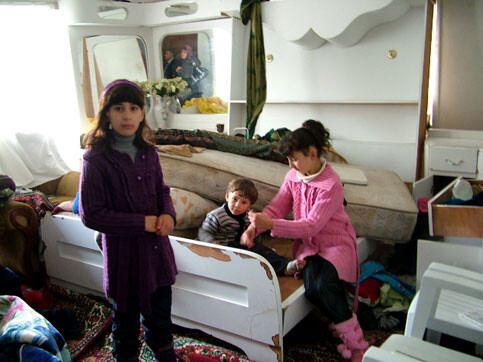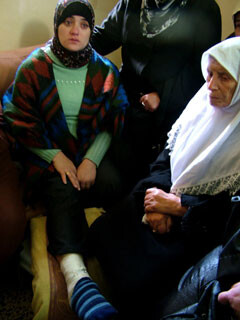
Anan Subih’s children in their damaged home.
The brutal killing of three Palestinian men by Israeli military forces in Nablus last week on 26 December 2009 sparked grief and outrage across Palestine and brought the northern West Bank city to a standstill as thousands mourned the lethal attack. However, their voices are drowned out yet again by a well-played hand of Israel’s propaganda machine and repeated by the mainstream media.
On the eve of the one-year anniversary of Israel’s winter invasion of Gaza, a force of several hundred Israeli soldiers entered Nablus and invaded the homes of Ghassan Abu Sharkh, Raed Sarakji and Anan Subih where they were executed in cold blood in front of family members. A statement by the Israeli military alleged that an operation was carried out to arrest the men suspected of involvement in the killing of an Israeli settler, Meir Avshalom Hai, two days earlier.
The portraits of the targeted men — armed perpetrators of another injustice — painted by the military’s statements have exploded throughout Israel’s media and beyond, subsequently footnoted by Israeli police’s forensic results, reporting a match between a rifle seized in the invasions and the weapon used to kill Hai, a rabbi and resident of the Shave Shomron settlement.
This postmortem revelation, which has not been verified by independent sources, raises alarming questions of Israel’s “shoot first, ask questions later” policy. It also echoes the disparities between the statements of the Israeli military, repeated by the Israeli and international media, and the testimony of the victims’ family members, which were collected by a handful of local media agencies and human rights organizations.

Ghassan Abu Sharkh’s wife, shot in the foot.
According to Tahani Jaara, the wife of Raed Sarakji, the Israeli military then forced their way in to their home in the Old City at 2:30am, where Sarakji was shot in the head immediately. The force of the close-range fire was so great that it caused his head to split in two. As his pregnant wife ran forward to catch his falling body she was shot in the foot. Only at this point did soldiers confirm the identity of the man just executed, ordering his wife to hand over both their IDs and mobile phones. Soldiers opened fire once again on his now lifeless body, then ordered his wife to summon their children to behold the grisly remains.
Half an hour later, Israeli soldiers entered Nablus’ Ras al-Ain neighborhood. Quickly occupying several homes surrounding the house of Anan Subih, soldiers began firing anti-tank missiles at the upper levels of the building, blowing a giant cavity between the third and fourth stories. Farid Subih, brother of Anan, reported that soldiers entered the house on foot, firing live ammunition and destroying property as they forced family members out in to the street. Subih was found hiding in the rubble created by rocket blasts, where he was immediately executed.
A spokesman for the Israeli army claimed that after the men “refused to leave their houses and surrender, we entered. They continued hiding and endangering our soldiers, which made the shooting imperative.” How these three men sleeping at home with their families endangered an overwhelming armed military force is unclear. As is the justification for brutally excessive force employed lethally against the targeted men and wantonly upon their family members, including children.
The Israeli military’s trigger-happy strategies for the “liquidation” of those deemed a security risk have resulted in the tragic loss of hundreds of civilian lives in so-called “targeted killing” operations, as a result of both mistaken identity and the excessive use of force employed, such as the launching of missiles from aircrafts, tanks or missile launchers at densely populated areas. Although this did not occur during the 26 December Nablus incursion, it is particularly disturbing that the Israeli military issued a post-execution clarification of at least one of the slain men’s identities.
Israel’s long history of such extrajudicial killing operations carried out in the Occupied Palestinian Territories (OPT) reached its height during and after the second Palestinian intifada. Israel’s assassination policy resulted in the deaths of 754 persons from December 2000 to June 2008 in 348 operations. As reported by the Palestine Centre for Human Rights in July 2008, 521 of those killed were targeted and 233 were bystanders.
Categorical execution without trial constitutes state terrorism, whatever statements military spokespeople may peddle regarding Israel’s exhaustive quest for “security” and the means necessary to enforce it. Whether or not Israeli intelligence’s suspicions of Sarakji, Sharkh and Subih were well-founded, the cold-blooded execution of these and hundreds of other victims are a grave departure from a human’s right to due process. Israel’s tired accusations of terrorism against those it kills are rarely supported by evidence, and only a handful of cases of those killed on these grounds have ever been investigated; fewer still have been accountable for their actions.
There are still plenty of questions left unanswered and will likely remain that way forever. Two groups of two factions, at entirely opposite ends of the political spectrum, claimed responsibility for the attack on the settler: the al-Aqsa Martyrs’ Brigade associated with the Fatah party and the fundamentalist Islamic Jihad.
Of the three men, Sarakji, released from a seven-year prison term last January, was the only one officially wanted by Israel for suspected involvement in the al-Aqsa Martyrs’ Brigade. In contrast, according to his brother, Subih had surrendered his arms and received a full governmental pardon some years ago, while Sharkh’s wife states her husband’s only link to armed struggle was through his brother, who was assassinated by Israeli forces in 2004.
Israel’s attempt to depict their actions as the standard routine of criminal inquiry is clearly a farce. However admissible the findings of the victim’s armed involvement may be in a court of law, it amounts to little when those accused have already been tried and found guilty by the barrel of a gun. Whether these men were guilty or innocent — they were executed without trial in cold blood. They leave behind traumatized children, grieving families and thousands of ex-prisoners and fellow citizens wondering who will be next.
All images by Bridget Chappell.
Bridget Chappell is an Australian activist and writer who has been working with the International Solidarity Movement in Palestine since August 2009. She is based in Nablus.



